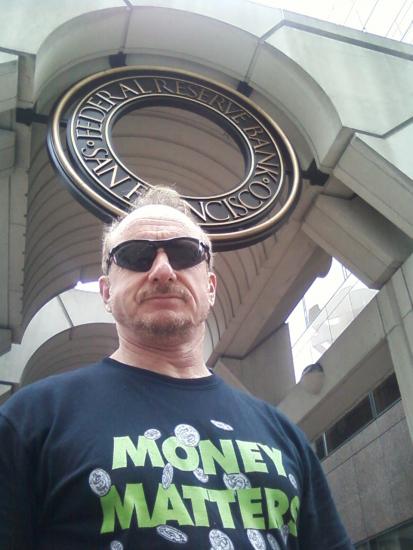
SCIM METHOD OF INVESTING UPDATE April 27, 2021

I am visiting the Federal Reserve in San Francisco
What they have to say is enlightening!
Read on dear reader............
THE DEBT CRISIS
It is no secret the U.S. government has amassed a lot of debt. Many people don’t give government debt much thought and indeed, some believe the government can just spend money on whatever it sees fit and the world will be better for it.
Thankfully, most politicians from both sides of the aisle realize, at least to some degree, that unbridled government spending is not ideal. History dictates an over spending government will eventually run the balance sheet into the rocky shoals of a national debt crisis.
The consequences of that, albeit a rare occurrence, can be very severe when it occurs, and the event affects almost every income level.
Government debt, like all debt, has to be paid back at some point. The idea that “deficits don’t matter” has been bantered about the political aisles from time to time, but deficits do matter in my house, and probably in yours as well. Public debt is no different, although some would like to think so.
Although the U.S. government has been running up deficits for years, the last two decades has seen an unprecedented acceleration. Y2K, 9/11, the dot.com blowup, and the 2008 real estate and banking implosion (among other events) were all deemed critical enough to warrant even more borrowing to address each crisis.
Because of Covid, the last 12 months has witnessed even more government spending and has dwarfed all other previous events.
Although spending does not necessarily imply debt accumulation, in the case of the U.S. government, most of the spending has been accomplished by fiat money creation (money printing), or by tapping the global credit markets, both of which just rack up more debt.
Considering it took about 200 years to amass the first trillion in government debt, total U.S. debt has now ballooned to 23 trillion in a few short decades. The last 12 months alone has seen about 6.8 trillion in new debt. This does not include the proposed two billion in infrastructure repair currently on the table from the Biden administration and billions more for ongoing assistance to the credit markets supporting U.S. financial and business institutions.
Keeping those figures in mind, an easy argument could be made the path we find ourselves on is unsustainable. Debt cannot be accumulated ad infinitum.
Since debt is future income brought forward and spent today, debt can only be repaid essentially by working for no pay sometime in the future, for what is earned only goes to paying back what was borrowed previously.
With 23 trillion in debt and climbing, the amount is so large, those paying most of the bill will likely not be the ones who borrowed it (us).
This means, unless the U.S. adopts the attitude that deficits do indeed matter, it will be our children (and their children) that will suffer the eventual consequences of our borrowing.
Some argue the spending is necessary to solve current crises and make a better future for future generations.
An easy argument to be made by those doing the borrowing.
In fact its so easy, borrowing has obviously been a commonplace solution for decades.
As to the actual consequences, many believe U.S. debt can be just wiped clean in some sort of jubilee event (see debt jubilee- Wikipedia).
If this is true, one could argue we should spend as much as possible and as fast as we can to fix all the ills in the world.
However, something (hopefully) in your brain tells you there is something amiss with this conclusion.
No matter what the reader believes, debt and deficits do matter.
History tells us without exception, debt cannot just be wiped clean, and that the more debt that is accumulated, the more difficult the payback will be.
It is argued that the money spent during the creation of all this debt has been necessary, whether it be for social improvements or crisis mitigation.
Whatever one believes, the burden we are leaving to future generations is real, is massive and is getting worse by the day.
If it’s our children’s money we are spending, and it is, might it be better left for them to decide what’s necessary at that time and for us to stop the borrowing?
Should we instead limit our own spending to what money we do have?
And if we don’t have enough for our current needs, to work harder and earn it ourselves?
Moreover, if the powers at be cannot make due with the trillions they already have, perhaps we should somebody in there that can?
These difficult questions must be answered at some point. Either that or we continue to nail future generations to the cross of our gross economic mismanagement.

---
SCIM METHOD OF INVESTING
Knowing when a market is setting up to correct is the Holy Grail in investing. Many advisors and investors adopt the methodology to just buy and hold. However, readers of Money Matters know I advocate a more hands-on approach to portfolio management that includes an attempt to accomplish some degree of portfolio protection.
What I mean by this is that investors can actively try to protect profits and guard against losses instead of just sitting on their hands by adopting some basic strategies.
Decades ago I developed such a method called “The Safe and Conscious Investing Methodology” (SCIM).
Let me begin by saying no one can predict market movements at any time and no guarantees can be offered that gains will be protected or losses will not be realized. After all, investing involves risk.
Much like the study of volcanos, volcanologists can look at what is happening but cannot guarantee what will happen. The same goes with market prognostications. There are no guarantees of any kind. If an investor cannot tolerate risk, they consider FDIC bank products and there are varying strategies to consider there as well.
To utilize SCIM means the advisor monitors various things not only happening in the markets, but in the economy as well.
Needless to say, an economic background would help facilitate this monitoring, for without such education, one would not know what to look for when it came to the economic portion of the strategy.
In lieu of using SCIM, the buy and hold strategy (which I call “do nothing” advisory) exists on the principal markets that always recover.
I am of the opinion the do nothing principal is flawed on the most fundamental of levels. Remember, advisors stating that markets always comes back is technically illegal. That illegality comes from the basic rule that advisors are strictly forbidden to guarantee any market direction of any kind at any time.
However, if one believes markets always come back, it is my opinion an advisor is not needed, and that one could just buy a broad market representative holding that attempts to mirror an index, purchased through a discount brokerage firm, and be done with it. With no advisor, there would obviously be no advisor fee as well.
The SCIM method, instead of just buying and holding, looks at a variety of events and movements in the market and economy, then considers what the markets have done in the past to guide the advisor as to what may happen in the future.
What to look for is the key when attempting to limit downside using SCIM.
An example of an SCIM event is illustrated stating the old adage that stocks and bonds have a tendency to move opposite of each other. Although not always true, it happens enough times for a mix of stocks and bonds to be a common recommended stock allocation rule.
(https://www.investopedia.com/articles/investing/062714/100-minus-your-age-outdated.asp).
SCIM looks at many events, including the stock and bond relationship, and how it is changing over a given period of time. Other observations in SCIM consider action in the Fed Funds arena, interest rates, the Repurchase Agreement facility, (REPO), overseas markets, currency fluctuations, political considerations and movements in certain market sectors like fixed income, consumers staples, utilities, preferred stocks, real estate investment trust (REIT) and other areas.
Although the reader may not fully understand all the considerations that SCIM looks at, just know that the events occurring in multiple areas of the economy and in the markets may alert an astute economist and an experienced advisor that something may be occurring beneath the surface that could erupt into a more serious event.
Although no methodology can guarantee anything when it comes to the stock market, much like a volcanologist who studies underground movements and occurrences beneath a potential volcano, there can also be tremors felt in the markets that may indicate something far more terrible is about to occur.
- Financial Services: All financial services offered through Vantage Financial Group. Click here to view: https://www.vantageauburn.com/marc-s-services
Opinions expressed here are those of Mr. Cuniberti and not those of any bank or investment advisory firm. Nothing stated is meant to insure a guarantee, or to be construed as investment advice. Neither Money Management Radio (“Money Matters”) receive, control, access or monitor client funds, accounts, or portfolios. For a list of the services offered by Mr. Cuniberti, call (530)559-1214. California Insurance License #0L34249 and Medicare Agent approved. Insurance services offered independently through Marc Cuniberti and not affiliated with any RIA firm or entity. Email: news@moneymanagementradio.com. No person or methodology can predict market movements of any kind. Past performance is no guarantee of future results.







